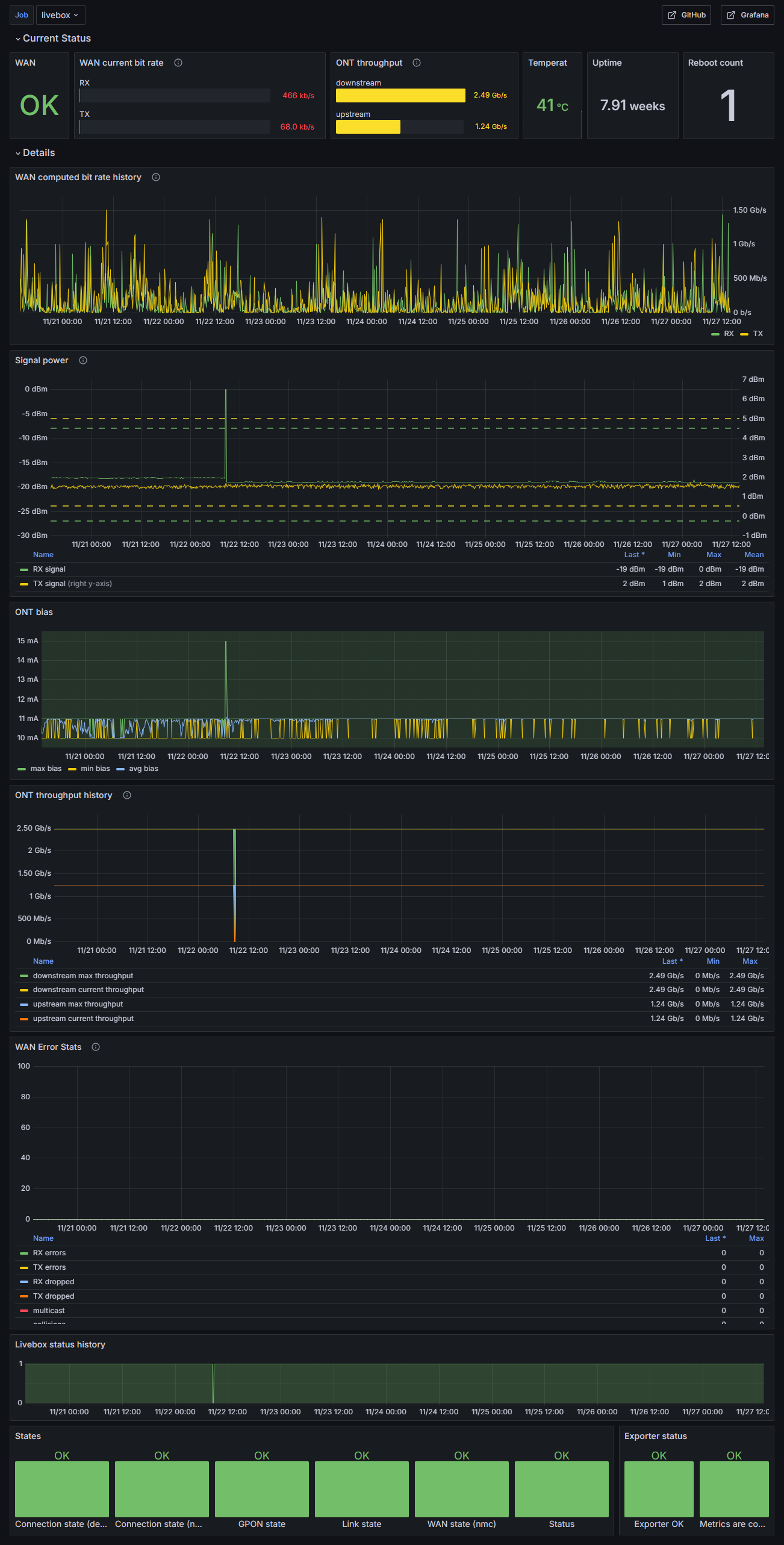This project exposes a subset of basic metrics from Orange Livebox 5 router. It is meant to be integrated with Prometheus.
Once deployed, endpoint /metrics returns a page of text-based metrics. Default URL will be: http://localhost:9105/metrics
You can get an idea of available metrics from this file LB5-metrics.csv located in embedded resources.
Dashboard for Grafana is available here: https://grafana.com/grafana/dashboards/21101-livebox/
This project is designed to run in the background continuously (headless and non interactive), to monitor the WAN connection status. My primarily goal was to measure stability of my Internet access at home.
If you are looking for an interactive desktop application, also with more features, see Livebox Monitor which works very well.
I also discovered even more alternatives after I made this project, you can look for them through the livebox topic on Github.
If you try to run program with default settings, it may work if you are lucky: Livebox address should be automatically detected if it is on same network (same subnet).
Without your admin password to authenticate to your Livebox, only a subset of metrics will be available.
As usual, application settings are in file appsettings.json, and these settings can be overriden by environment variables.
It's best to configure program with your own settings, especially these keys:
- Host: IP address of your Livebox (eg: "192.168.1.1")
- Password: password of admin user on your Livebox. Alternatively, you can also set a setting PasswordFile with path of a file containing this password.
Port and network interface to listen can be set with setting urls. Default is http://localhost:9105.
Program can be run from either:
- From provided binary (windows-x64 and linux-x64). See Releases section.
- From docker image.
- By compiling different kind of binary from source code.
There is little point in running this program alone. You typically need also to setup:
- Prometheus (completely free and open-source)
- Grafana (completely free if you choose the OSS edition)
Docker image is published on Docker Hub.
Examples of resource manifests:
apiVersion: v1
kind: Secret
metadata:
name: livebox-exporter-secret
type: Opaque
stringData:
admin-password: "YOUR PASSWORD"
---
apiVersion: apps/v1
kind: Deployment
metadata:
name: livebox-exporter-deployment
labels:
app: livebox-exporter
spec:
replicas: 1
selector:
matchLabels:
app: livebox-exporter
template:
metadata:
labels:
app: livebox-exporter
spec:
volumes:
- name: secret-volume
secret:
secretName: livebox-exporter-secret
containers:
- name: livebox-exporter
image: eric1901/livebox-exporter
volumeMounts:
- name: secret-volume
readOnly: true
mountPath: "/var/secret/"
env:
- name: urls
value: "http://*:9105"
- name: Livebox__Host
value: "192.168.1.1"
- name: Livebox__PasswordFile
value: "/var/secret/admin-password"You legitimately may want to restrict egress network policy of this pod.
Assuming you already have setup a restrictive network policy, here is an example of a policy to allow egress from livebox-exporter pod to your livebox (you may need to adapt CIDR value):
apiVersion: networking.k8s.io/v1
kind: NetworkPolicy
metadata:
name: livebox-exporter-networkpolicy
spec:
podSelector:
matchLabels:
app: "livebox-exporter"
egress:
- to:
- ipBlock:
cidr: 192.168.0.0/16
ports:
- protocol: TCP
port: 80
policyTypes:
- EgressIf you do not already have a restrictive egress policy, here is an example. You may adapt it to your needs. Be aware applying this policy may break connectivity of other pods.
apiVersion: networking.k8s.io/v1
kind: NetworkPolicy
metadata:
name: default-deny-all-egress
spec:
podSelector: {}
egress:
- to:
- ipBlock:
cidr: 10.0.0.0/10
ports:
- protocol: TCP
port: 53
- protocol: UDP
port: 53
policyTypes:
- EgressOnce applied, you can play with the livebox-exporter-networkpolicy (delete / apply) to see that livebox-exporter cannot or can reach your livebox.
For example, if you simply want to expose this API outside of the Kubernetes cluster, use a NodePort service type:
apiVersion: v1
kind: Service
metadata:
name: livebox-exporter-service
labels:
app: livebox-exporter
spec:
type: NodePort
selector:
app: livebox-exporter
ports:
- name: http
port: 9105
protocol: TCP
targetPort: 9105
nodePort: 30080The API will be accessible via http://Your-Kubernetes-Cluster-Ip:30080/metrics.
Alternatively, if you have a reverse proxy inside another pod on same cluster, use a ClusterIP service type:
apiVersion: v1
kind: Service
metadata:
name: livebox-exporter-service
labels:
app: livebox-exporter
spec:
type: ClusterIP
selector:
app: livebox-exporter
ports:
- name: http
port: 9105
protocol: TCP
targetPort: 9105At home, I use an nginx as a reverse proxy, with this virtual server configuration inside conventional directory conf.d (mounted through a persistent volume claim):
server {
listen 80;
server_name YOUR-SERVER-NAME;
location /livebox {
proxy_pass http://livebox-exporter-service:9105;
proxy_set_header Host $host;
proxy_set_header X-Real-IP $remote_addr;
proxy_set_header X-Forwarded-For $proxy_add_x_forwarded_for;
proxy_set_header X-Forwarded-Proto $scheme;
proxy_set_header X-Forwarded-Prefix /livebox;
}
}
My nginx runs inside another pod on same Kubernetes single-node cluster and its port 80 is exposed on a node port 30080 (whithin default exposed port range of my K3S).
So http://localhost:30080 points to my nginx pod, and any URL starting with prefix /livebox is directed to http://livebox-exporter-service:9105.
My Prometheus instance runs on same server, but not inside Kubernetes. Then, scrape URL from Prometheus running on same server is: http://localhost:30080/livebox/metrics.
